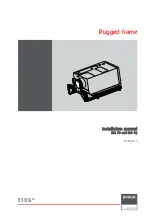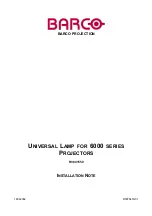
1-8
INTRODUCTION
ORBAN MODEL 9300
2)
The low-frequency
3 dB point of the system must be placed at 0.15Hz or lower
(this is not a misprint!). This is necessary to ensure less than 1% overshoot in a
50Hz square wave and essentially constant group delay to 30Hz.
3)
Any preemphasis used in the audio transmission system prior to the transmitter
(such as in an STL) must be canceled by a precisely complementary deemphasis:
Every pole and zero in the preemphasis filter must be complemented by a zero
and pole of identical complex frequency in the deemphasis network. An all-pole
deemphasis network (like the classic series resistor feeding a grounded capaci-
tor) is not appropriate.
In this example, the network could be corrected by adding a second resis-
tor between ground and the capacitor, which would introduce a zero.
Low-pass filters (including anti-aliasing filters in digital links), high-pass filters, trans-
formers, distribution amplifiers, and long transmission lines can all cause the above
criteria to be violated, and must be tested and qualified. It is clear that the above
criteria for optimal control of peak modulation levels are met most easily when the
audio processor directly feeds the transmitter. While OPTIMOD-AM’s transmitter
equalizer can mitigate the effects of group delay and frequency response errors in
the signal path, an accurate path will still achieve the best results.
Best Location for OPTIMOD-AM
The best location for OPTIMOD-AM is as close as possible to the transmitter so that
OPTIMOD-AM’s output can be connected to the transmitter through a circuit path
that introduces the least possible change in the shape of OPTIMOD-AM’s carefully
peak-limited waveform. This connection could be short lengths of shielded cable (for
transmitters with analog inputs) or a direct AES3 connection (if the transmitter has a
digital input available). If this is impossible, the next best arrangement is to feed the
9300’s AES3 digital output through an all-digital, uncompressed path to the trans-
mitter's exciter.
If the programming agency’s jurisdiction ends at the link connecting the audio facil-
ity to the transmitter, a variety of problems can occur downstream. (The link might
be telephone/post lines, analog microwave radio, or various types of digital paths.)
The link, the transmitter, the transmitter peak limiters, or the transmitter itself can
all introduce artifacts that a studio-located audio processor cannot control.
If the transmitter is not accessible:
All audio processing must be done at the studio and you must tolerate any damage
that occurs later. If an uncompressed AES3 digital link is available to the transmitter,
this is an excellent, accurate means of transmission. However, if the digital link em-
ploys lossy compression, it will disturb peak levels by up to 4 dB. Lossy compression is
also inappropriate for another reason: it cannot accommodate pre-emphasized au-
dio (like OPTIMOD-AM‘s output) without introducing serious artifacts.
Unlike FM, where the transmitter usually can be set up to provide pre-
emphasis, AM transmitters are universally “flat.” Therefore, unlike FM,
there is no option when using lossy compression to de-emphasize at the
Summary of Contents for OPTIMOD-AM 9300
Page 1: ...Operating Manual OPTIMOD AM 9300 Digital Audio Processor Version 2 0 Software...
Page 7: ...Operating Manual OPTIMOD AM 9300 Digital Audio Processor Version 2 0 Software...
Page 178: ...3 46 OPERATION ORBAN MODEL 9300...
Page 200: ......
Page 221: ...OPTIMOD AM DIGITAL TECHNICAL DATA 6 21...
Page 222: ...6 22 TECHNICAL DATA ORBAN MODEL 9300 CONTROL BOARD PARTS LOCATOR...
Page 228: ...6 28 TECHNICAL DATA ORBAN MODEL 9300...
Page 229: ...OPTIMOD AM DIGITAL TECHNICAL DATA 6 29 I O DSP BOARD LEFT AND RIGHT ANALOG INPUTS...
Page 230: ...6 30 TECHNICAL DATA ORBAN MODEL 9300 I O DSP BOARD ANALOG OUTPUTS...
Page 231: ...OPTIMOD AM DIGITAL TECHNICAL DATA 6 31...
Page 238: ...6 38 TECHNICAL DATA ORBAN MODEL 9300 FRONT VIEW REAR VIEW FRONT PANEL PARTS LOCATOR DIAGRAM...
















































